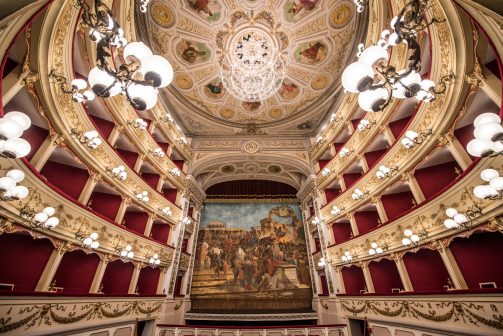A cultural and social landmark of the city of Chieti and a symbol of the aristocratic and bourgeois class of the time, the Marrucino Theater was built, beginning in 1813, on the site of the formerly deconsecrated church of Sant’Ignazio. Inaugurated in 1818 with a performance of G. Rossini’s La Cenerentola, it was originally named after St. Ferdinand in honor of King Ferdinand I of Bourbon and, only in 1861, with the Unification of Italy, did it assume the name Marrucino. As its prestige grew, over the years it underwent major enlargement and embellishment: examples include the great wooden rose window in the hall, the precious curtain by the Neapolitan painter Giovanni Ponticelli, depicting the triumph of the Theatine Asinio Pollione, and the two terracotta sculptures by Costantino Barbella. In 2001 it was recognized as Teatro Lirico d’Abruzzo and in 2003 as Teatro di Tradizione. On the occasion of its bicentennial in 2018, the Marrucino, a monument owned by the Municipality of Chieti, obtained the issuance of a commemorative stamp, and since 2021, with the support of the Superintendence, it has become an inclusive theater, capable of reducing and breaking down the physical barriers that precluded its access and prominence to the disabled. A place of preservation of opera singing, the Marrucino today is an absolute protagonist in live performance in Abruzzo.









